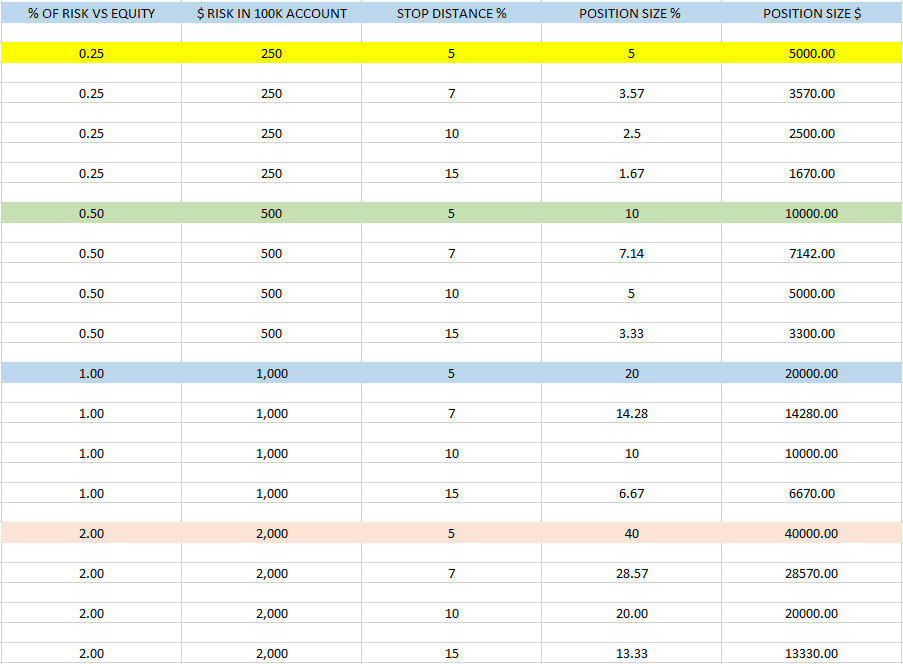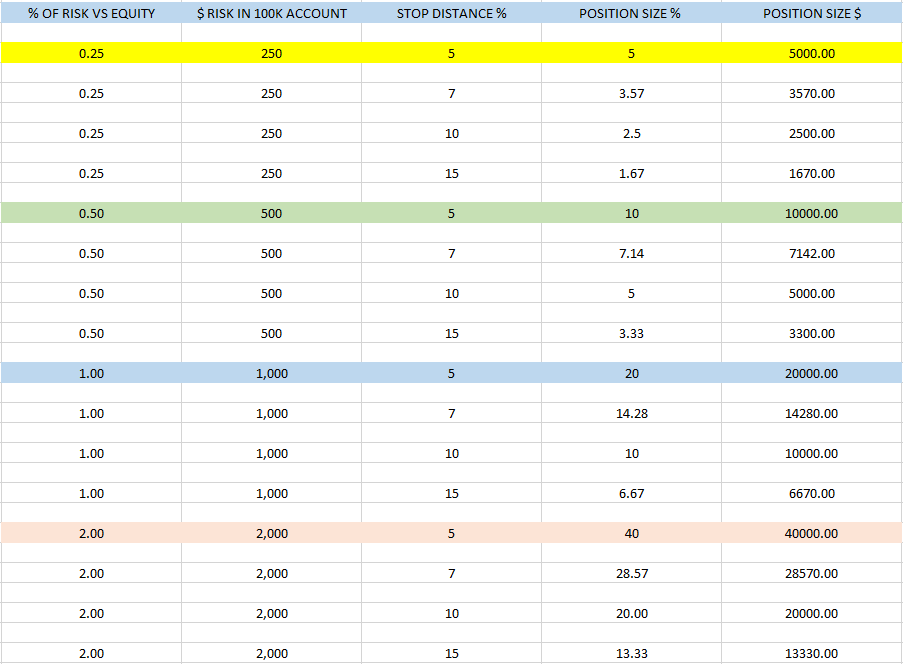YouTube Video: https://youtu.be/udtCj51WCFA
Position Sizing and Risk Management
(For purposes of this educational post, a hypothetical $100,000 account value will be assumed, for ease of calculation).
1. Risk management is one of the most important factors to a trader or investors longevity.
– If you go broke, you can’t trade or invest.
– If you have a major drawdown, it can take years to recoup.
– Always focus on risk management and position management, especially when considering new positions.
2. Total open risk.
– Traders/investors should first determine how much total open risk they want to carry at any one time.
– If ALL positions get stopped out and/or closed, what is the total loss vs portfolio equity, in percentage terms?
3. Definition of Risk.
– We will define risk here by the amount that can be lost in the position if it is stopped out, not the total $ invested.
– Example: If a trader puts $10,000 into a position with a 5% stop loss, the ‘risk’ here is not $10,000, it is the 5% potential loss on the $10,000 investment, or $500.
– In a $100,000 account, $500 risk = 0.50%, or 1/2 of 1%, or 50-basis points. They are all the same.
– Standard ‘total open risk’ levels for many professional often falls into the 5-10% range, at any one-time.
– For many professionals, market volatility often dictates how much open risk they will hold.
– In low-volatility, uptrend markets, open risk is often much higher as a target level, than it is in choppy, volatile, news-driven markets.
– For this illustration, we will assume the trader/investor wants to have 5% of ‘total open risk’.
4. Once target ‘open risk’ is determined (5% in our example) – New position risk needs to be calculated before entering a position.
5. New risk also needs to be added to current open risk, to determine ‘total open risk’ or ‘total exposure’.
– The new position risk added needs to be added to current open risk.
6. Position risk.
– To determine position risk, multiply the percentage weight of the position x the stop loss % level.
– A 10% position with a 10% stop = 1.00% of risk.
– A 10% position with a 5% stop = 0.50% risk.
7. Fixed allocation sizing vs fixed risk sizing.
– Traders/investors might choose to start with a fixed allocation size, example 5% per position, and then calculate the stop level from there.
– Some choose to risk a fixed amount per trade (25 bps, 50 bps, 100 bps) and then determine position size and stop from there.
1. Determine target portfolio total open risk. (5%, 10%, etc)
2. Determine target risk per position. (RPP) (25bps, 50bps, 1oo bps)
3. Determine stop loss level. (SLL)
4. (RPP) x (SLL) = Position size

25-BPS RISK
A 5% position in a $100,000 account = $5,000 of stock purchased.
If the investor has a 5% stop loss and the position hits the stop, then the account will lose $250.
($5,000 position x 5% to the stop = $250).
$250 lost in a $100K account = 1/4 of 1% lost, or 25-basis points.
In this scenario, if an investor was stopped out of 4 trades in a row, they would lose 1% of their starting account value.
($250 lost in position x 4 positions = $1,000 or 1% of account value).
50-BPS RISK
If the investor has a 10% stop loss and a $5,000 position, or 5%, and the position hits the stop, then the account will lose $500 or 50-basis points.
5% position x 10% stop.
10% position x 5% stop.
20% position x 2.5% stop.
4 trades stopped out in a row = -2% vs equity
100-BPS (1%) RISK
A 10% stop loss and a $10,000 position (10%) = 1% of risk.
5% position x 20% stop.
10% position x 10% stop.
20% position x 5% stop.
4 trades stopped out in a row = -4% vs equity.


